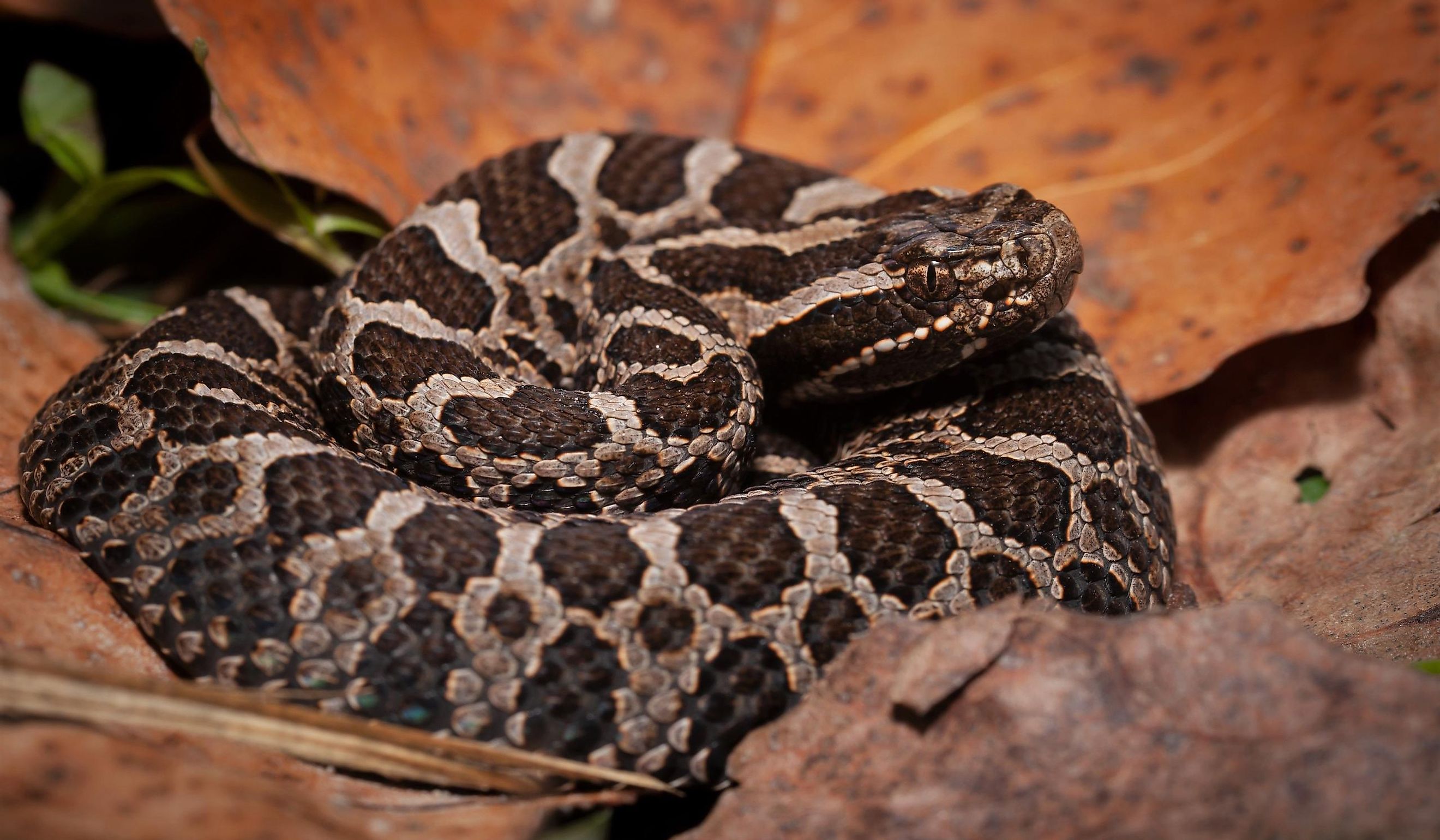
Which State Has More Venomous Snakes: Ohio Or Michigan?
Over centuries, snakes have evolved to adapt to the ever-changing environments. Herpetologists (snake experts) hypothesize that snakes evolved from terrestrial lizards to the modern slithering creatures seen today.
Snakes can be found around the world and have adapted to various habitats to include the skills needed to survive dense rainforests, barren deserts, and wooded forests. Snakes are of the reptile family, and like all reptiles, they regulate their body temperatures through various behaviors. When they are cold, they bask in the sun for warmth. When it is hot, they retreat to shady places or water to cool themselves.
To survive freezing temperatures, snakes fall into a state of brumation or deep sleep. During brumation, the snake's body temperature drops, which slows the metabolism as well. Unlike hibernation, where an animal may eat enough food to survive the winter, in brumation, snakes cannot fully digest food. Some snakes brumate for the entire winter, while other species are more cold tolerant and wake to sun themselves on warmer days.
All snakes are predators, hunting for food, but venomous snakes inject venom from their fangs into their prey to immobilize - and sometimes kill - their victims. Across the United States, there are a number of species of venomous snakes, most of which are in the rattlesnake family. All rattlesnakes are pit vipers.
Pit vipers are equipped with a heat-sensing pit between each eye and nostril, providing them with the ability to "see" at night. This special vision allows them to make accurate strikes, even in the dark.
As neighbors, Ohio and Michigan experience similar climates throughout the year, with warm sunny days in the summer and snowy winters. Snakes are most active from spring to fall, as they become more active in warmer months. So, which midwestern state has more venomous snakes, Ohio or Michigan?
Ohio
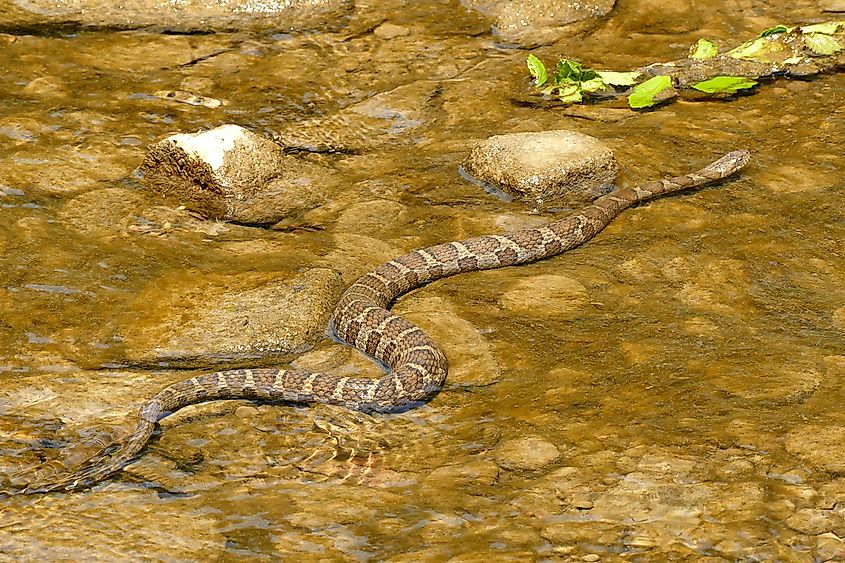
Weather in Ohio fluctuates with the changing of the seasons. In the peak of summer, the high can get around 85 degrees Fahrenheit, while in the winter, as low as -20. Ohio suffers severe weather during the winter as cold, dry fronts from Canada and the warmer air from the Gulf of Mexico stream through.
Ohio's geography consists of plains; however, some regions have rolling hills and twisting river valleys. The Till Plains cover Ohio's western half, while the stony Appalachian Plateau covers the eastern half. Rivers within the state include the Cuyahoga River, Great Miami River, Maumee River, Muskingum River, and Scioto River.
Ohio Snakes
With rugged terrain, forests, and rivers, snakes have an abundance of locations to call home. Ohio snake species can be found inside and outside city limits, where food and shelter can be easily acquired. Ohio is home to about thirty-three species of snakes, but only three are venomous.
Timber Rattlesnake
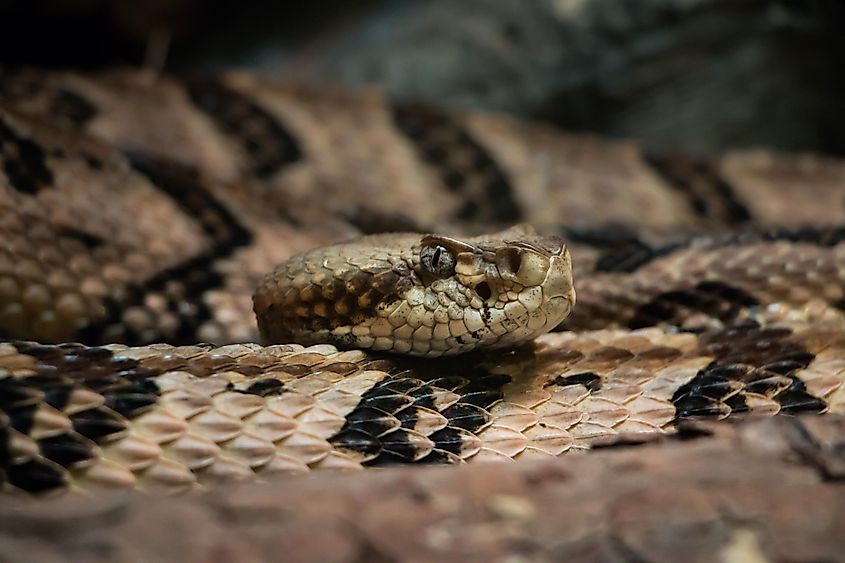
Identifiable features: Timber rattlesnakes can be identified by two color phases, the black and the yellow phase, seen in both males and females. In the black phase, the crossband design is less noticeable against a black background, whereas in the yellow phase, the crossband design is against a yellow background.
Adult Timber rattlesnakes have an average length of three to four feet, but they can also grow up to seven feet long. Due to its size, in addition to being venomous, this species of snake has earned the reputation of being "most dangerous."
Habitat: Timber rattlesnakes have been found in a variety of habitats. They can live in mountainous or hilly forests, hardwood or pine forests, swamps and river floodplains, lowland thickets, and agricultural fields. Timber rattlesnakes are amazing climbers, with some found in trees more than 80 feet high!
Diet: In the wild, timber rattlesnakes eat small to medium-sized rodents, including mice, shrews, chipmunks, and squirrels. Their diet also includes birds, lizards, and amphibians. They are ambush predators who will wait patiently for prey to pass by and then quickly strike, bite, and inject venom before consuming.
Northern Copperhead
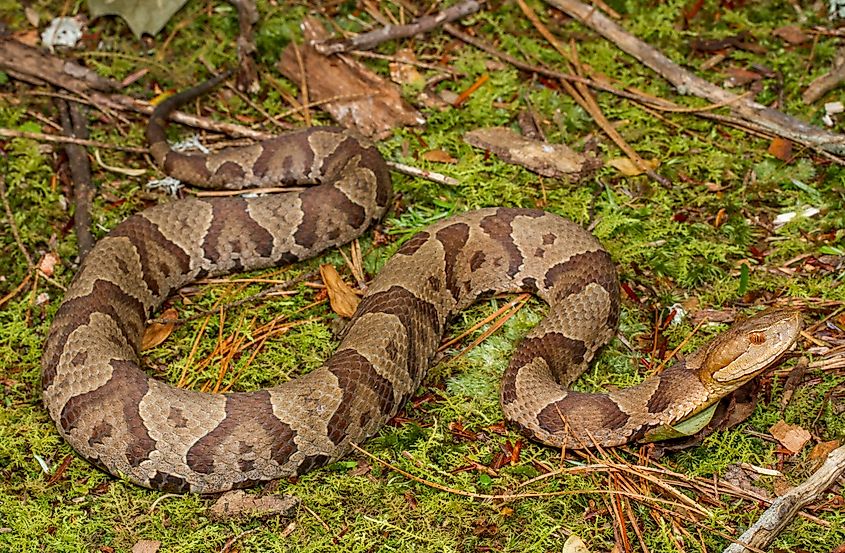
Identifiable features: Copperhead markings are usually hourglass-shaped, with the narrower parts crossing the back of the snake over the tailbone. The markings range from brown to orange, which helps them camouflage along forest floors. Copperheads have a pale-colored upper lip which is visible even from a distance away. Juvenile Copperheads have a yellow-tipped tail that fades away around age three or four. This tipped tail is used as a worm-like lure to attract prey. Copperheads can grow to between 24 and 36 inches long, with the largest recorded at 52 inches long.
When encountered, the Copperhead remains motionless, relying on camouflage to remain undetected. Due to their excellent ability to blend in, many bites occur because a person accidentally steps or grabs them while working in their garden. This has earned the species the reputation for "coming out of nowhere."
Habitat: In Ohio, Copperheads reside in the southern counties in the western half of the state. They are also found everywhere, apart from the northern counties in the eastern half. They prefer rocky or wooded slopes where they can blend but have been found to make homes in abandoned building materials such as rotting wood or piles of sawdust.
Diet: Copperheads feed on a wide variety of prey, including mice, amphibians, and insects such as cicadas.
Eastern Massasauga
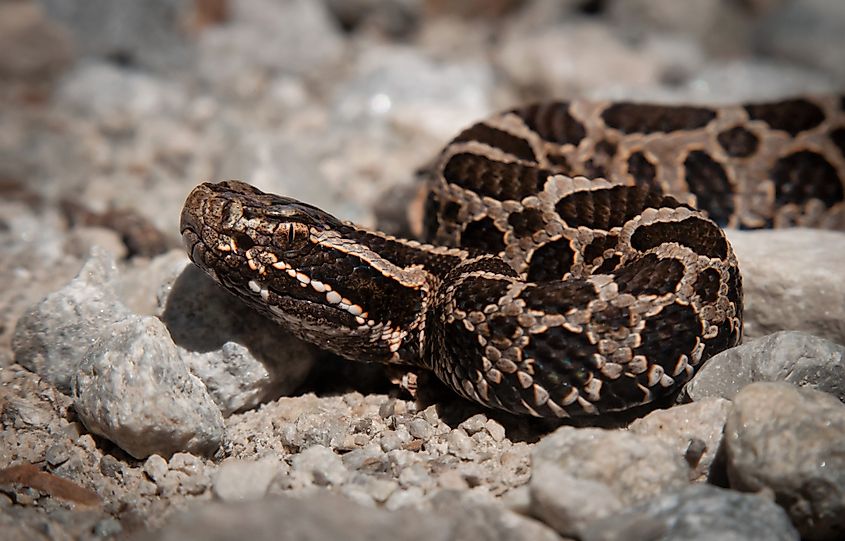
Identifiable features: The Eastern Massasauga was named for its preference towards wetlands, with Massasauga meaning "Great River Mouth" in the language of the Native American Chippewa Tribe. This species has an average length of around two feet. This small snake is dark-colored with 29 to 50 dark blotches on a gray or brownish-gray body. On either side of the body are three rows of smaller dark spots. Although venomous, people are rarely bitten by the Eastern Massasauga snake due to its elusive and shy behavior, and it is considered non-aggressive.
When threatened, Eastern Massasaugas will remain motionless, depending on their camouflage to blend into their surroundings, hoping to be unseen. Sometimes, they sound their rattle before striking, but they will also strike without rattling, particularly when surprised.
The rattle of the Eastern Massasauga sounds differs from traditional rattlesnake species. The rattle has been described as a buzzing sound, much like the sound of a bee that is trapped in a spider web.
Habitat: The Eastern Massasauga resides in isolated places in the wet prairies of western and northern Ohio. During winter, Eastern Massasaugas use crayfish burrows for protection below the frost line for brumation. Due to an increase in depleting habitat spaces, indiscriminate killing, and illegal collection, the Eastern Massasauga is endangered.
Diet: This snake species feeds almost entirely on small mammals, including voles, moles, jumping mice, and shrews, while occasionally consuming amphibians.
Michigan
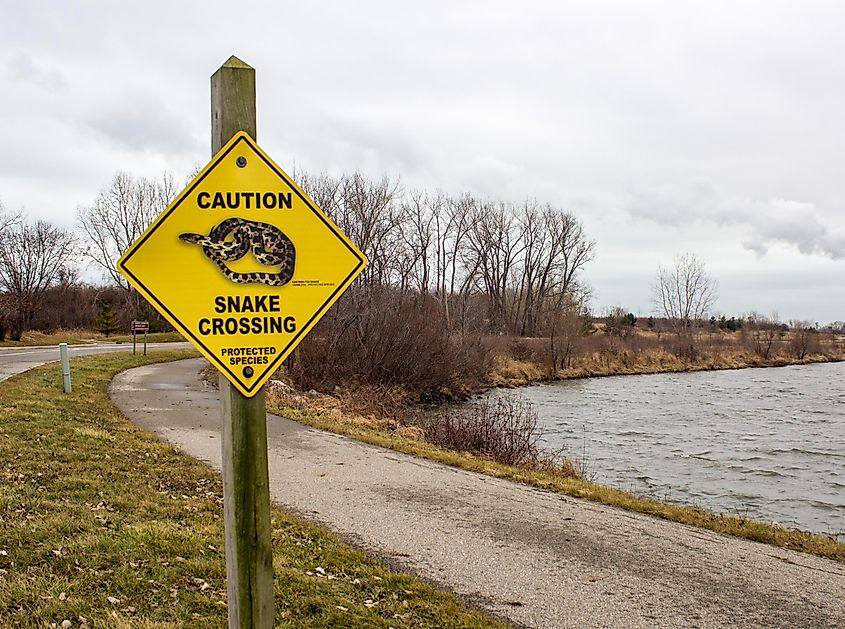
Michigan is framed by four out of five Great Lakes (Lake Erie, Lake Huron, Lake Michigan, and Lake Superior), earning it the name "The Great Lake State." On Michigan's southern borders are Ohio and Indiana.
The state is split into two parts: the Upper Peninsula and the Lower Peninsula. In the north, the Upper Peninsula contains mountainous terrain. The Lower Peninsula is shaped like a mitten and occupies the majority of the state's land mass, which mainly features relatively flat areas and plains.
With so much water, Michigan has a humid climate. The southern and central parts of the Lower Peninsula have a warmer climate. The summers in this region are hot and humid, while the winters are cold but shorter.
Closer to the lakes, the northern part of the Lower Peninsula and the entire Upper Peninsula have a more severe climate. Summers are warm and humid but shorter. Winters are long and very cold, averaging below-freezing from December through February.
Michigan Snakes
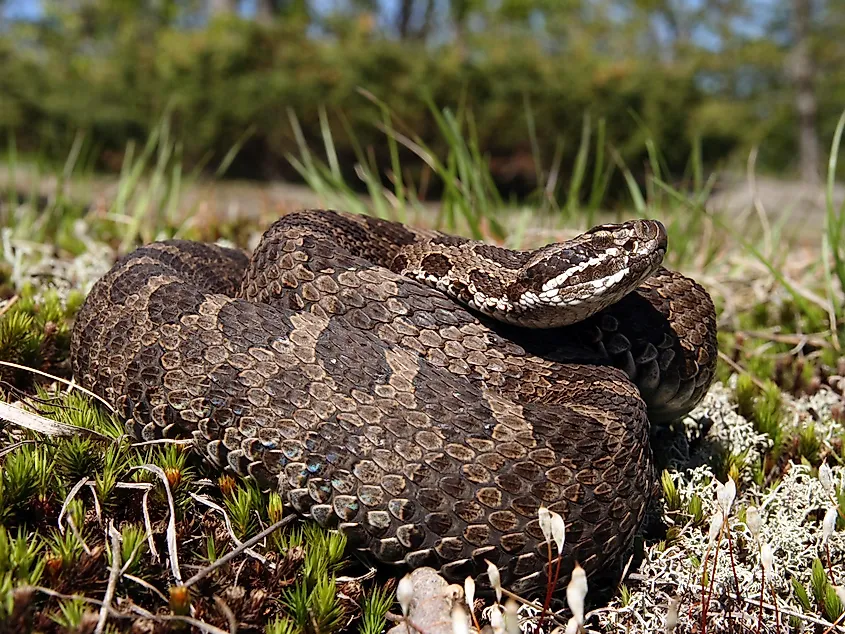
The Upper Peninsula features low-rolling hills in the east and rugged terrain in the west. Meanwhile, Michigan's Lower Peninsula is home to ridged hills, beaches, and forested areas. With a variety of terrain and climates, Michigan is home to eighteen species of snakes. Only one is venomous, the Eastern Massasauga.
When seen, the small rattlesnake is found hiding under wooded debris or vegetation in a variety of wetland habitats. Each winter, Eastern Massasaugas reuse the same brumation den, usually abandoned mammal holes, but also tree roots and rock crevices. Closer to civilization, these small snakes have been found in submerged trash, barn floors, and basements.
In Michigan, the shorter warm season results in the snakes tucking into their dens for the winter sooner than in Ohio. In the Spring, Eastern Massasaugas bask anywhere in the sun to warm their bodies, usually on elevated locations, including beaver lodges. When their bodies are warm enough, they take a short migration to their summer territory, which is often less than two miles away.
Eastern Massasaugas are more active during the day in spring and fall. In the summer, their schedule switches to more activity in the mornings and evenings. Using their pits, hunting is precise and easy in the dark.
Ohio Versus Michigan
Both Ohio and Michigan are home to numerous species of snakes, including venomous snakes. Ohios's climate and geography provide a rugged landscape, an ideal habitat for venomous snakes. The state's rocky terrain makes hiding and hunting prey easy. On the other hand, Michigan's vast topography and proximity to the Great Lakes provide more habitat opportunities, including wetlands. Ohio is home to three venomous snakes as opposed to Michigan, which inhabits only one. While Eastern Massasaugas live in both Ohio and Michigan, Ohio is home to more venomous snakes.











